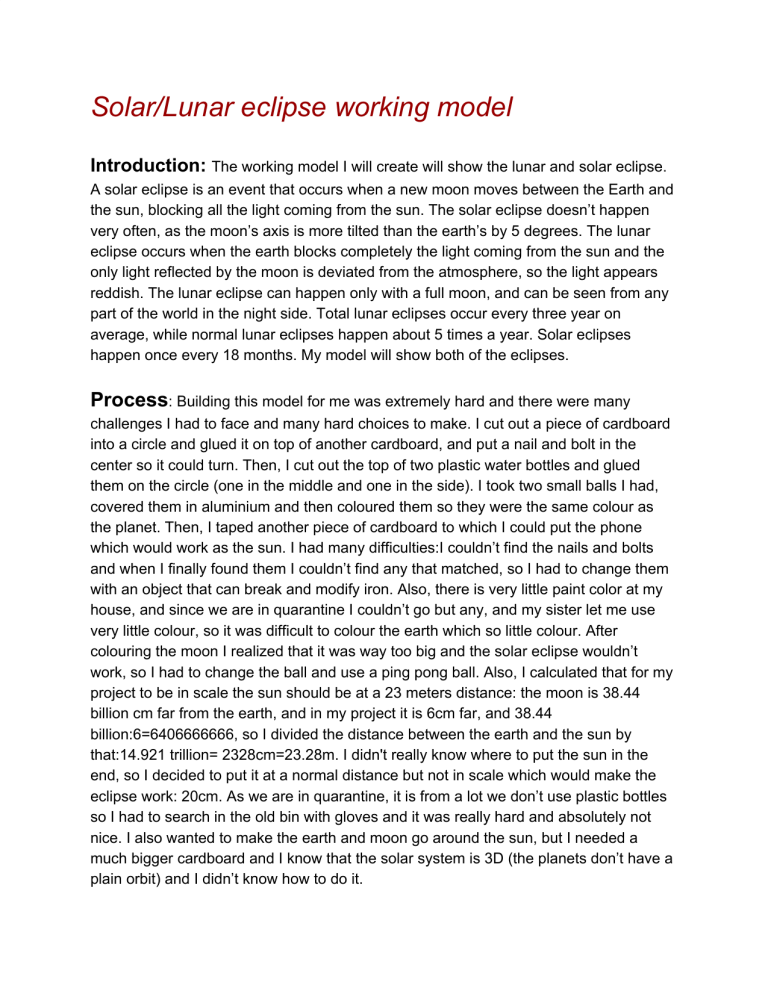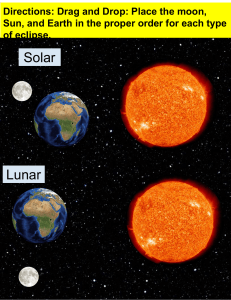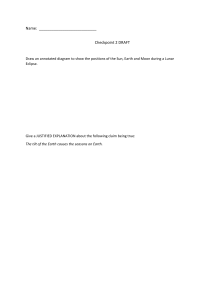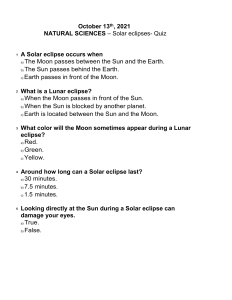
Solar/Lunar eclipse working model Introduction: The working model I will create will show the lunar and solar eclipse. A solar eclipse is an event that occurs when a new moon moves between the Earth and the sun, blocking all the light coming from the sun. The solar eclipse doesn’t happen very often, as the moon’s axis is more tilted than the earth’s by 5 degrees. The lunar eclipse occurs when the earth blocks completely the light coming from the sun and the only light reflected by the moon is deviated from the atmosphere, so the light appears reddish. The lunar eclipse can happen only with a full moon, and can be seen from any part of the world in the night side. Total lunar eclipses occur every three year on average, while normal lunar eclipses happen about 5 times a year. Solar eclipses happen once every 18 months. My model will show both of the eclipses. Process: Building this model for me was extremely hard and there were many challenges I had to face and many hard choices to make. I cut out a piece of cardboard into a circle and glued it on top of another cardboard, and put a nail and bolt in the center so it could turn. Then, I cut out the top of two plastic water bottles and glued them on the circle (one in the middle and one in the side). I took two small balls I had, covered them in aluminium and then coloured them so they were the same colour as the planet. Then, I taped another piece of cardboard to which I could put the phone which would work as the sun. I had many difficulties:I couldn’t find the nails and bolts and when I finally found them I couldn’t find any that matched, so I had to change them with an object that can break and modify iron. Also, there is very little paint color at my house, and since we are in quarantine I couldn’t go but any, and my sister let me use very little colour, so it was difficult to colour the earth which so little colour. After colouring the moon I realized that it was way too big and the solar eclipse wouldn’t work, so I had to change the ball and use a ping pong ball. Also, I calculated that for my project to be in scale the sun should be at a 23 meters distance: the moon is 38.44 billion cm far from the earth, and in my project it is 6cm far, and 38.44 billion:6=6406666666, so I divided the distance between the earth and the sun by that:14.921 trillion= 2328cm=23.28m. I didn't really know where to put the sun in the end, so I decided to put it at a normal distance but not in scale which would make the eclipse work: 20cm. As we are in quarantine, it is from a lot we don’t use plastic bottles so I had to search in the old bin with gloves and it was really hard and absolutely not nice. I also wanted to make the earth and moon go around the sun, but I needed a much bigger cardboard and I know that the solar system is 3D (the planets don’t have a plain orbit) and I didn’t know how to do it. Evaluation and reflection: I think that overall my model represents the phenomenon very well, but t here are many “mistakes”, and some of them annoy be fixed, so overall it has strengths and weaknesses. It has many strengths such as: the moon and the earth are in similar sizes as they are real life, and they’re color is just right. The lunar eclipse is shown very well and also the solar (even if it should be slightly smaller). Another strength is that it shows the moon going around the earth smoothly. Some weaknesses are: the sun is too close, if it was in proportion it should be about 24 meters away. The earth and the moon don’t go around the sun, but I think that is not very important as I was supposed to show the eclipses, not the solar system, and it would have been hard to do as earths orbit around the sun is not “flat”. The earth doesn’t turn around itself as fast as it should. Since none of the objects turn round the sun, I can’t show why the solar eclipse doesn’t happen every month.



